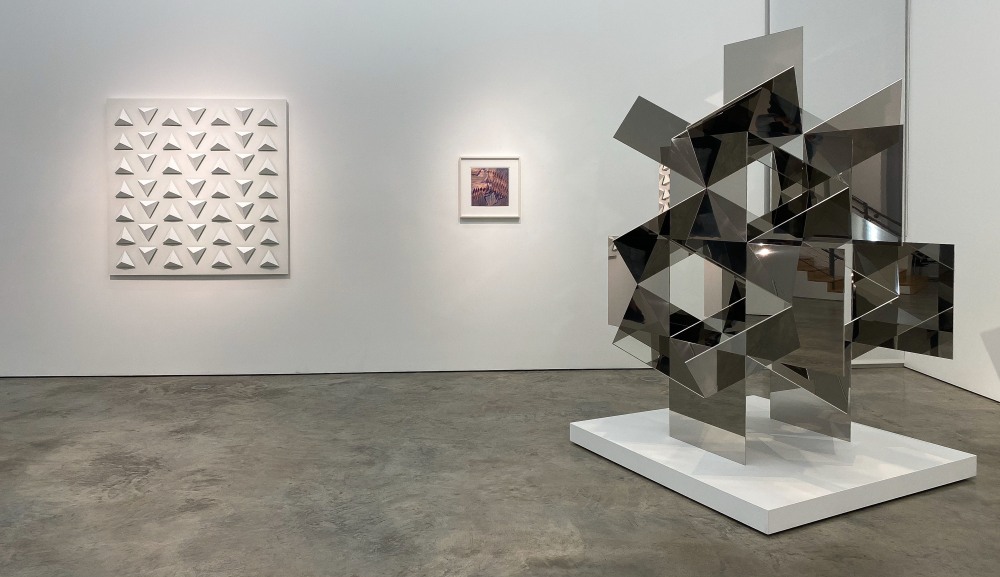
Luis Tomasello, Gego, and Francisco Sobrino on view at Sicardi | Ayers | Bacino.
Three Houston gallery shows to see now
Grids, animated drawings and luminous paintings can tease perception simply.
Molly Glentzer January 5, 2021Updated: January 5, 2021, 7:31 pm
So, you’ve watched every season of every TV series ever made and played computer games until your brain and thumbs ache, and this latest pandemic flare-up is doing nothing to help you wake from the stupor. Maybe your eyeballs could use a shot of art. Here are three shows whose artists play purposefully with visual perception, using an inspired simplicity of means.
‘The Grid in Modern Latin American Art’
The venerable Sicardi|Ayers Bacino represents the estates of many of the masters whose works fill the Latin American rooms of the Museum of Fine Arts, Houston’s new Kinder Building. This show organized for December’s virtual Art Basel Miami fair underscores the relationship. Its vintage but timeless kinetic pieces are by nine artists who enlivened Paris in the 1950s and ’60s, knew each other and used the grid as a starting point to explore color and form.
Francisco Sobrino’s faceted sculpture “Transformation Instable” (designed in 1971 and fabricated in 2013) stars like a giant magnet, pulling other works into view with its intersecting planes of mirrors. Sobrino and Julio Le Parc were among the founders of the experimental collective Visual Art Research Group. “They would go out onto the streets and involve people,” says Melissa Caspary, the gallery’s marketing director. Le Parc’s lighted “Continuel Lumiere,” also a showstopper, contains hanging, reflective squares against a painted wood support.
Color plays a role in the effects of works by Carlos Cruz-Diez, Mercedes Pardo, Antonio Asis, Luis Tomasello and Alejandro Otero. While many of Cruz-Diez’s later works are technology driven (the new “Cromosaturación MFAH” tunnel is one of his last designs), the artist’s hands are more present in early, muted works such as 1968’s “Physichromie 377.” Asis’ small gouaches from the 1960s work their magic without fuss, too. Asis, Tomasello and others continued to tease the eyes with basic but elegant Op Art techniques late into their careers.
Be sure to go upstairs, where a companion show of Jesús Rafael Soto’s kinetic beauties resides.
By appointment, through Jan. 16; Sicardi|Ayers Bacino, 1506 W. Alabama, 713-529-1313, sicardigallery.com
‘Hedwige Jacobs: Come Alive for a Few Seconds’
The small, silhouetted figures Hedwige Jacobs drew by hand and animated to create videos in 2020 could be any or all of us. Some scurry like ants. Some do cartwheels or stretch. Others are isolated, banging against walls or trying to crawl through cracks. Barely more than stick figures, they somehow hold loads of human complexity in their futile motions.
“We’re all alone, but we’re all together,” Jacobs says in a video walk-through of her first solo show at Anya Tish Gallery. Visitors literally join the scene as their huge shadows appear among the 120 busy figures of the quirky animated projection “Personal Space.” A smattering of stationary figures drawn on the wall keep viewers grounded as they’re immersed in a blank, white world of computer-generated busyness. Everyone’s going somewhere and seemingly nowhere, with no destinations in sight.
“I’m interested in how people behave in space and towards each other, and how they share their personal space, which is ever changing,” says Jacobs, a Dutch artist who lives in Houston.
Sometimes she draws on found materials such as small, deconstructed boxes, but Jacobs also uses household objects as canvases. The show’s large installation holds a fantasy room of these works, many of which incorporate a woven pattern that’s as imperfect and enchanting as the little figures.
11 a.m.-5 p.m. Thursdays-Saturdays, through Jan. 16; Anya Tish Gallery, 4411 Montrose; 713-524-2299, anyatishgallery.com
‘Ruth Pastine: Spectrum Depths’
Color field painter Ruth Pastine, who aims for the sublime, responded to the pandemic’s first months with a series of eyepoppingly bright works that shout with urgency but also offer a luminous antidote, glowing with hopefulness.
Her optically resonant paintings also challenge perceptions of color, light and space. Each one vibrates around nuances, reducing spectrums of yellow, blue, green and red to elemental forms with thousands of small brush strokes that resolve and appear seamless, as if they’re made of no material you could touch.
You might need sunglasses to gaze at “Yellow 7” in particular, but the exercise makes for an ethereal escape.
1-5 p.m. Mondays-Saturdays, through Feb. 27; Gallery Sonja Roesch, 2309 Caroline; 713-659-5424, gallerysonjaroesch.com
molly.glentzer@chron.com
Follow:
Molly Glentzer
Molly Glentzer, a staff arts critic since 1998, writes mostly about dance and visual arts but can go anywhere a good story leads. Through covering public art in parks, she developed a beat focused on Houston's emergence as one of the nation's leading "green renaissance" cities.
During about 30 years as a journalist Molly has also written for periodicals, including Texas Monthly, Saveur, Food & Wine, Dance Magazine and Dance International. She collaborated with her husband, photographer Don Glentzer, to create "Pink Ladies & Crimson Gents: Portraits and Legends of 50 Roses" (2008, Clarkson Potter), a book about the human culture behind rose horticulture. This explains the occasional gardening story byline and her broken fingernails.
A Texas native, Molly grew up in Houston and has lived not too far away in the bucolic town of Brenham since 2012.